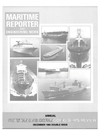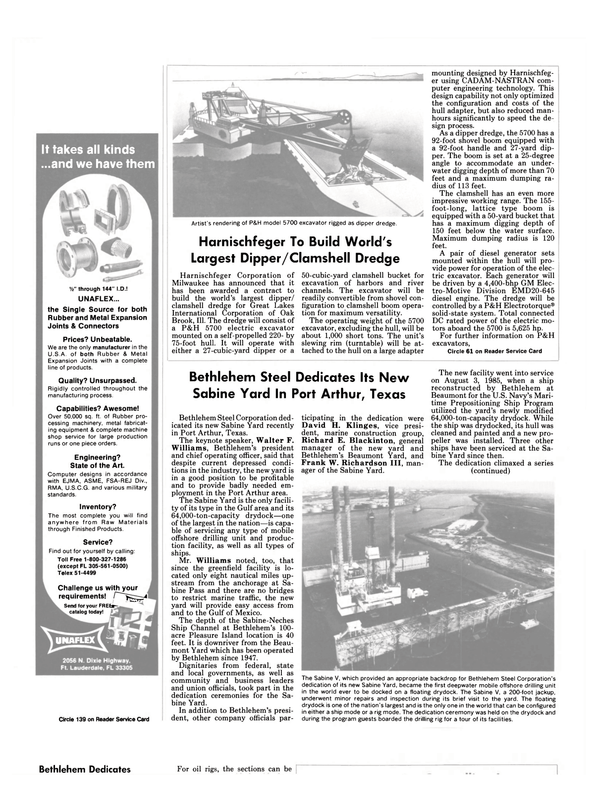
Kockums To Build Ferry With First Coal-Fired Marine Steam Engines In 30 Years
Skinner Engine Company, Erie, Pa., a subsidiary of Banner Industries Inc., has announced that the first marine steam engines specified for a coal-fired vessel in more than 30 years will soon power a Polish - owned ferry engaged in trans-Baltic service. Delivery of the engine room package is scheduled for October 1986.
David McArthur, manager for Skinner's Steam Engine Group, reported that the multimillion-dollar contract calls for two 4.0-MW multi- cylinder Skinner compound unaflow engine sets as propulsion machinery for a train/car passenger vessel. The ferry is being built by a Swedish shipyard, Kockums AB (Malmo, Sweden) for the Polish Baltic Steamship Company. The vessel will operate between Ystad, Sweden, and Swinoujacie, Poland.
He also reported that the entire engine room package will be manufactured and delivered by an Anglo- American consortium of companies, which, in addition to Skinner, includes: Romac Limited of Shoebury, Essex, UK, consortium coordinator; Senior Green Limited of Wakefield, UK, manufacturer of boilers and automated coal combustion equipment; and Peter Brotherhood Limited of Peterborough, UK, manufacturer of turbine generator sets.
Members of the consortium currently are engaged in negotiations with the shipyard and another Polish shipping company to produce similar propulsion systems for as many as twelve 6,700-dwt bulk carriers for coal trade.
"This order for a coal-fired ship propelled by Skinner steam engines comes on the heels of a great deal of research throughout the shipbuilding industry for a return of this dependable, efficient alternative for marine power following years of oil dependence," said Skinner president R. Dennis Whiting. "It is the result of concerted effort by four suppliers who have pooled their knowledge, resources and facilities.
"We believe that there is a bright future for this type of propulsion," he added, "as well as for the steam engine itself for numerous applications including biomass energy systems and cogeneration. The steam engine, once thought to be dead, is alive and well." "This propulsion system will employ the first of a new generation of low-speed steam engines applied in a modern coal-fired setting," Mr.
McArthur stated. "It signals a rebirth of a once-popular power source as a viable alternative for any vessel given the proper engineering and economic circumstances." Mr. McArthur explained that Skinner's Compound Unaflow Marine steam engines offer superior maneuverability compared with diesel or turbine powered propulsion.
Because it has no minimum continuous operating speed, full torque is available at a dead stall ahead or astern, allowing faster and more effective transfer of power to the propellers.
Similarly, it enables rapid and complete reversibility for optimum response in emergency situations.
The Marine Compound engine, like most other steam engines, is highly regarded for its long life and low operating and maintenance costs. Several of the coal-fired Skinner Compounds built for vessels in Great Lakes service following World War II remain in operation today.
Mr. McArthur pointed out that the "proper economic circumstances" for this propulsion alternative would be found in nations with ready supplies of coal, but small or no native sources of petroleum.
"Beyond the appreciable price difference between native coal and imported oil, a nation must consider the social cost of having currency spent outside the country on petroleum rather than at home on coal," he said. "That currency is likely to serve the nation far better at home.
For these reasons, we believe there will be a market for coal-fired, marine steam engines in Europe, India, Africa, South America and elsewhere in the Third World." While applications of this technology for large commercial vessels will require a home port with coal handling facilities, Skinner and its associates have developed a system with dual firing boilers so that oil— although less economical—can be a standby in emergencies.
Polish shipping authorities were first approached by Romac Limited regarding this propulsion technology in 1983 when they declared an interest in building coal-fired vessels to take maximum advantage of a native energy resource.
"Since that time," said Romac's managing director Derek McNamara, "we have endeavored to develop a coal-fired engine room package which would prove technicallly, commercially and financially viable.
"Coal-fired turbines were considered but did not project as favorably economically as steam engines," Mr.
McNamara noted. "Capital and maintenance costs for turbines would have been higher. Moreover, turbines would not offer equivalent maneuverability. In particular, there would be less horsepower on demand for reversing engines.
"Working closely with Skinner, Senior Green and Peter Brotherhood, we arrived at a design concept— featuring two engines, two boilers and two turbo alternators— that met the engineering and economic criteria of both the shipyard and the ferry operators." The major reason for selecting the Skinner Compound Marine Steam Engine is greatly reduced operating costs—chiefly due to availability of inexpensive coal—to be enjoyed during the expected 30-year life of the steam engines.
For brochures and complete information on the Skinner Compound Marine Steam Engine, Circle 55 on Reader Service Card
Read Kockums To Build Ferry With First Coal-Fired Marine Steam Engines In 30 Years in Pdf, Flash or Html5 edition of December 1985 Maritime Reporter
Other stories from December 1985 issue
Content
- United States Cruises Applies To M a r A d For $150-Million Title XI page: 4
- PA Series Heavy Fuel Diesel Now Available From Fairbanks Morse page: 6
- Six-Page Color Brochure On Energol Lubricants Offered Free By BP Marine page: 6
- Getty Fleet Orders Lips Speed-Adapted Propellers To Increase Efficiency page: 6
- Karl Senner Offers Free Color Brochure On Reintjes Marine Gearboxes page: 6
- OMSA Elects New Officers —Congressman Warns Of California Plan' page: 8
- Birka Line Cruise Ship Launched At Valmet's Helsinki Shipyard page: 8
- Fire Combat, Inc. Offers 10-Page Manual On Fire Suppression Systems page: 9
- Texaco Appoints Quegan General Manager, Marine Department page: 10
- Fernstrom Elected President And CEO Of American Ship Building page: 10
- New Briefcase Computer For Marine Industry From NAV-COM page: 12
- Furuno USA Introduces New Doppler Speed Log And ARPA Line page: 12
- W. Anthony Watt Heads Sales And Marketing Division At Moran Towing page: 14
- Marinette Delivers First Of Ten Torpedo Weapons Retrievers page: 14
- Bassett Named President Of Interocean Management page: 14
- Kockums To Build Ferry With First Coal-Fired Marine Steam Engines In 30 Years page: 16
- COSCO And McMullen Form New Company— COSCO North America page: 17
- Cunard Gives $115-Million Contract To Lloyd Werft To Convert QE2 To Diesel And Alter Accommodations page: 17
- Harnischfeger To Build World's Largest Dipper/Clamshell Dredge page: 18
- Bethlehem Steel Dedicates Its New Sabine Yard In Port Arthur, Texas page: 18
- Totem To Acquire Controlling Interest In Interocean Steamship Corp. page: 20
- OUTSTANDING OCEANGOING SHIPS OF 1985 page: 22
- NOTABLE CONVERSIONS OF 1985 page: 44
- Bender Shipbuilding Wins $4.5 Million In Contracts page: 49
- Construction of 'Theodore Roosevelt' Ahead Of Schedule And Under Budget page: 50
- Magnavox Introduces New Generation SatCom And New GPS/Transit SatNav Receivers page: 51
- GPS/Transit SatNav Receivers page: 52
- Network 90, Integrated Marine Management System For Reduced Costs And Maximized Profits page: 55
- SHIPBOARD COMPUTER SURVEY page: 58
- Ellicott Machine Corporation Announces Personnel Changes page: 68
- Vapor Corporation Announces New Sphere Matrix Technology page: 68
- U.S. NAVY SHIP PROCUREMENT Second Quarterly Update—November 1985 page: 70
- MSI Conducting Tests For Proposed Canadian Ferry With Voith Schneider Propulsion page: 77
- Design Improvements In EMD's 645FB Diesel Provide Higher Horsepower, Better Fuel Economy page: 78
- Perko Presents The 200 Series International Navigation Lights page: 81
- Coast Guard Completes Installation Of Advanced Navigational Aid In N.Y. Harbor page: 85
- Macmeter Offers Metering Protection page: 91
- MARDATA Named North American Agent For Lloyd's Information Services page: 91


